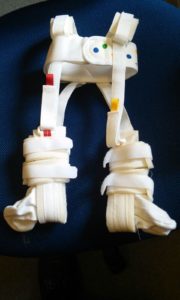Back to: Trial Questions
Questions:

A 2-week old baby girl is referred to your clinic by the Paediatric team with concerns regarding an audible clunk on movement of the right hip.
1) How might you manage this?
2) What is the Graf index and how does it help with the management of this condition?
3) Can you describe the different components of the Pavlik harness? When do you use it? How successful is it?
4) What are the possible contra-indications and risks of the Pavlik harness?
1. Obtain a full history from the mother regarding antenatal and birth history (breech presentation after 36 weeks irrespective or delivery method is a risk factor), family history (1st degree relatives) and other risk factors – sex, first born, packing disorders. Examination would include full assessment of lower limbs including asymmetry of abduction (>20 degree difference between legs has a 90% specificity, 70% sensitivity), leg length discrepancy, Galleazi test, and then Barlow and Ortolani tests. For an infant with clinical findings supporting a dislocatable hip, an USS would be requested urgently and performed within 2 weeks of birth. Treatment would involve Pavlik harness with serial USS to monitor response to treatment. The frequency of the USS scans is dependent on local departmental protocol but typically may be every 2-4 weeks. 2. Graf (1984) developed an USS index, which is undertaken in a mid-coronal view. This is widely used today to help assess the position of the femoral head in addition to shape of the acetabulum, progression with serial USS investigation and determine the treatment. 4. A Pavlik harness is contra-indicated in cases of major muscle imbalance, e.g. Arthrogryposis. Whilst treatment with a Pavlik harnesses reported to be 92% successful, the risks include failure, avascular necrosis (1 to 2.3%), femoral nerve palsy and fixed posterior dislocation with damage to posterior acetabulum. In dislocated hips a 2 week USS to ensure the hip is reduced should be performed. If the hip remains dislocated the harness should be abandoned and a closed reduction/hip spica planned. Pavlik harnesses require regular monitoring and patients need access to medical staff to re-size the harness as the baby grows to ensure it remains effective throughout the course of treatment.3. A Pavlik harness is a dynamic flexion abduction orthosis which is widely used to treat DDH in infants up to the age of 6 months. The two main components help to restrict extension and adduction in order to centre the hips within the immature acetabulum thereby helping it to develop. A brace round the thighs and extending to stirrups at the feet with straps going over the shoulders. The anterior strap maintains hip flexion. The lateral straps provide hip abduction. The aim is to centre the hips within the safe zone. Hip flexion 90-110 degrees and abduction 40-60 degrees is generally a satisfactory Further readingAnswers:
Type α angle (°) β angle (°) Conclusion
I >60 - Normal
IIa 50-59 - Under 3/12 of age, physiological immaturity
IIb 50-59 - Delayed ossification in a child over 3/12 of age
IIc 43-49 <77 Severely dysplastic, close to decentring
IId 43-49 >77 (i.e. labrum everted) Severely dysplastic, close to decentring
III <43 >77 Dislocated
IV <43 >77 Dislocated but labrum interposed between the femoral head and acetabulum
